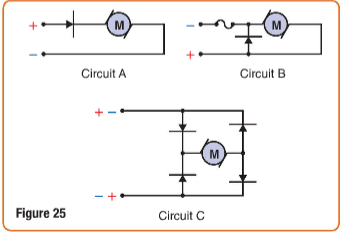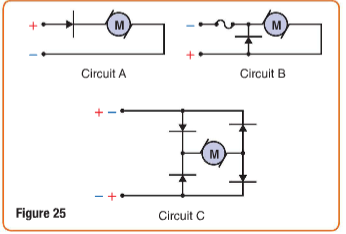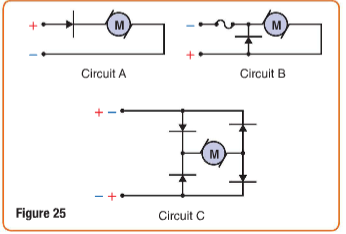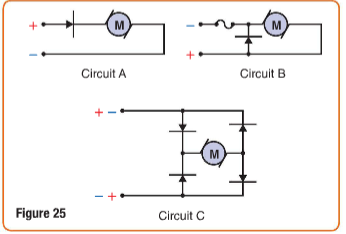
(a)
The circuit which allows the motor to run in only one direction.
(a)
Answer to Problem 74A
In circuit A, the motor runs in one direction.
Explanation of Solution
Given:
The figure:

As per problem
Consider the circuits in given figure
In circuit A, the forward biased diode is in series with the motor, so the current flows through the motor directly.
In circuit B, the diode is in parallel with the motor, so the current id divided between the diode and the motor.
In circuit C, there are two series diode connected parallel to each side of the motor, hence again the current is divided and the motor does not runs in a single direction.
Hence only in circuit A, the motor runs in one direction.
Conclusion:
In circuit A, the motor runs in one direction.
(b)
The circuit which will cause a fuse to blow if the incorrect polarity is applied.
(b)
Answer to Problem 74A
The circuit B will cause the fuse to blow if the incorrect polarity is applied.
Explanation of Solution
Given:
The figure:

In circuit B, a fuse is connected in series with the parallel circuit of motor and diode. If incorrect polarity, that is, positive terminal is connected to the fuse directly, it will overload and blow.
Conclusion:
The circuit B will cause the fuse to blow if the incorrect polarity is applied.
(c)
The circuit that produces the correct direction of rotation irrespective of the polarity applied.
(c)
Answer to Problem 74A
The circuit C produces the correct direction of rotation irrespective of the polarity applied.
Explanation of Solution
Given:
The figure:

In circuit C, either of the diodes connected to the left side of the motor will be forward-biased irrespective of the polarity applied. Subsequently the diodes connected on the right side of the motor will be forward biased or reverse-biased depending on the biasing of the right hand side diodes. Thus s the motor will rotate in the correct direction irrespective e of the polarity.
Conclusion:
The circuit C produces the correct direction of rotation irrespective of the polarity applied.
(d)
The advantages and disadvantages of the three circuits.
(d)
Answer to Problem 74A
The circuit A has the advantage of simplicity, the motor runs in one direction only.
Its disadvantage is the diode voltage drop is y
The circuit B has the advantage that the diode voltage y
Its disadvantage is that the fuse may blow if polarity is incorrect.
The circuit C has the advantage that the motor runs in correct direction irrespective of the polarity.
Its disadvantage is that 1
Explanation of Solution
Given:
The figure:

The circuit A has the advantage of simplicity, the motor runs in one direction only.
Its disadvantage is the diode voltage drop is
The circuit B has the advantage that the diode voltage
Its disadvantage is that the fuse may blow if polarity is incorrect.
The circuit C has the advantage that the motor runs in correct direction irrespective of the polarity.
Its disadvantage is that
Chapter 29 Solutions
Glencoe Physics: Principles and Problems, Student Edition
Additional Science Textbook Solutions
Brock Biology of Microorganisms (15th Edition)
Chemistry: An Introduction to General, Organic, and Biological Chemistry (13th Edition)
Campbell Biology: Concepts & Connections (9th Edition)
Applications and Investigations in Earth Science (9th Edition)
Introductory Chemistry (6th Edition)
Chemistry: The Central Science (14th Edition)
- I need help with problems 93 and 94arrow_forwardSince the instruction says to use SI units with the correct sig-fig, should I only have 2 s for each trial in the Period column? Determine the theoretical period of the pendulum using the equation T= 2π √L/g using the pendulum length, L, from Data Table 2. Calculate the % error in the periods measured for each trial in Data Table 2 then recordarrow_forwardA radiography contingent are carrying out industrial radiography. A worker accidentally crossed a barrier exposing themselves for 15 seconds at a distance of 2 metres from an Ir-192 source of approximately 200 Bq worth of activity. What dose would they have received during the time they were exposed?arrow_forward
- In the following figure the circuit to the left has a switch thatat t = 0 s is switched and disconnects the battery from the circuit. The state depicted on thefigure is right after the switch, still t = 0. As the current decreases over time, the magneticflux through the circuit on the right (due to the long cable of the circuit on the left) changesand induces an EMF on the right circuit. How much power is consumed by R2 as a functionof time.The distance between the wire on the left and the closest wire on the right is r = 2.0 cm.The size of the circuit on the right is noted on the figure.arrow_forwardsingly A samply ionized helium atom is in the ground state. It absorbs energy and makes a transition to the n=7 excited state. The ion returns to wo the wavelength the ground state by emitting SIX photons ONLY. What is the of the second highest energy photon ?arrow_forwardAn electron, traveling at a speed of 5.60x10° m/s, strikes the target of an X-ray tube. Upon impart, the eletion decelerates to one-third of it's original speed, with an X-ray photon being emitted in the process. What is the wavelength of the photon? m.arrow_forward
- Can you help me solve this 2 question and teach me what we use to solve thisarrow_forwardYou are working during the summer at a company that builds theme parks. The company is designing an electromagnetic propulsion system for a new roller coaster. A model of a substructure of the device appears in the figure below. Two parallel, horizontal rails extend from left to right, with one rail behind the other. A cylindrical rod rests on top of and perpendicular to the rails at their left ends. The distance between the rails is d and the length of the rails is L. The magnetic field vector B points vertically down, perpendicular to the rails. Within the rod, the current I flows out of the page, from the rail in the back toward the rail in the front. The rod is of length d = 1.00 m and mass m = 0.700 kg. The rod carries a current I = 100 A in the direction shown and rolls along the rails of length L = 20.0 m without slipping. The entire system of rod and rails is immersed in a uniform downward-directed magnetic field with magnitude B = 2.30 T. The electromagnetic force on the rod…arrow_forwardBased on the graph, explain how centripetal force is affected when the hanging mass changes. Does your graph verify the relationship in the equation r = x^i + y^j = r cos ωt I + r sin ωt^j?arrow_forward
- Can you help me to solve this two questions can you teach me step by step how to solve it.arrow_forwardGiven: ruler 11.56 g, small washer 1.85 g each, large washer 24.30g each Use the data in Data Tables 4 and 5 to experimentally determine the mass of your ruler. Use one of your 2 trials with 1 small washer at 0 cm, one of your 2 trials with 2 small washers at 0 cm, and one of your 2 trials with 3 small washers at 0 cm to find three experimental values for the mass of the ruler. How do you experimentalls determine the mass?arrow_forwardCompare the 3 experimental masses of your ruler to the measured mass of your ruler (Data Table 1) by calculating the percent error for each experimental value. Which trial provided the best data for determining the mass of the ruler? Please help, I am not sure how to calculate this. Thanks!arrow_forward
 College PhysicsPhysicsISBN:9781305952300Author:Raymond A. Serway, Chris VuillePublisher:Cengage Learning
College PhysicsPhysicsISBN:9781305952300Author:Raymond A. Serway, Chris VuillePublisher:Cengage Learning University Physics (14th Edition)PhysicsISBN:9780133969290Author:Hugh D. Young, Roger A. FreedmanPublisher:PEARSON
University Physics (14th Edition)PhysicsISBN:9780133969290Author:Hugh D. Young, Roger A. FreedmanPublisher:PEARSON Introduction To Quantum MechanicsPhysicsISBN:9781107189638Author:Griffiths, David J., Schroeter, Darrell F.Publisher:Cambridge University Press
Introduction To Quantum MechanicsPhysicsISBN:9781107189638Author:Griffiths, David J., Schroeter, Darrell F.Publisher:Cambridge University Press Physics for Scientists and EngineersPhysicsISBN:9781337553278Author:Raymond A. Serway, John W. JewettPublisher:Cengage Learning
Physics for Scientists and EngineersPhysicsISBN:9781337553278Author:Raymond A. Serway, John W. JewettPublisher:Cengage Learning Lecture- Tutorials for Introductory AstronomyPhysicsISBN:9780321820464Author:Edward E. Prather, Tim P. Slater, Jeff P. Adams, Gina BrissendenPublisher:Addison-Wesley
Lecture- Tutorials for Introductory AstronomyPhysicsISBN:9780321820464Author:Edward E. Prather, Tim P. Slater, Jeff P. Adams, Gina BrissendenPublisher:Addison-Wesley College Physics: A Strategic Approach (4th Editio...PhysicsISBN:9780134609034Author:Randall D. Knight (Professor Emeritus), Brian Jones, Stuart FieldPublisher:PEARSON
College Physics: A Strategic Approach (4th Editio...PhysicsISBN:9780134609034Author:Randall D. Knight (Professor Emeritus), Brian Jones, Stuart FieldPublisher:PEARSON





